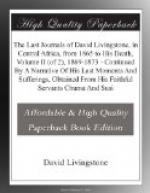29th November, 1870.—Safura is the name of the disease of clay or earth eating, at Zanzibar; it often affects slaves, and the clay is said to have a pleasant odour to the eaters, but it is not confined to slaves, nor do slaves eat in order to kill themselves; it is a diseased appetite, and rich men who have plenty to eat are often subject to it. The feet swell, flesh is lost, and the face looks haggard; the patient can scarcely walk for shortness of breath and weakness, and he continues eating till he dies. Here many slaves are now diseased with safura; the clay built in walls is preferred, and Manyuema women when pregnant often eat it. The cure is effected by drastic purges composed as follows: old vinegar of cocoa-trees is put into a large basin, and old slag red-hot cast into it, then “Moneye,” asafoetida, half a rupee in weight, copperas, sulph. ditto: a small glass of this, fasting morning and evening, produces vomiting and purging of black dejections, this is continued for seven days; no meat is to be eaten, but only old rice or dura and water; a fowl in course of time: no fish, butter, eggs, or beef for two years on pain of death. Mohamad’s father had skill in the cure, and the above is his prescription. Safura is thus a disease per se; it is common in Manyuema, and makes me in a measure content to wait for my medicines; from the description, inspissated bile seems to be the agent of blocking up the gall-duct and duodenum and the clay or earth may be nature trying to clear it away: the clay appears unchanged in the stools, and in large quantity. A Banyamwezi carrier, who bore an enormous load of copper, is now by safura scarcely able to walk; he took it at Lualaba where food is abundant, and he is contented with his lot. Squeeze a finger-nail, and if no blood appears beneath it, safura is the cause of the bloodlessness.
FOOTNOTES:
[8] A precisely similar epidemic broke out at the settlement at Magomero, in which fifty-four of the slaves liberated by Dr. Livingstone and Bishop Mackenzie died. This disease is by far the most fatal scourge the natives suffer from, not even excepting small-pox. It is common throughout Tropical Africa. We believe that some important facts have recently been brought to light regarding it, and we can only trust sincerely that the true nature of the disorder will be known in time, so that it may be successfully treated: at present change of air and high feeding on a meat diet are the best remedies we know.—ED.
[9] Dr. Livingstone never ceased to impress upon Europeans the utter necessity of living on the high table-lands of the interior, rather than on the sea-board or the banks of the great arterial rivers. Men may escape death in an unhealthy place, but the system is enfeebled and energy reduced to the lowest ebb. Under such circumstances life becomes a misery, and important results can hardly be looked for when one’s vitality is preoccupied in wrestling with the unhealthiness of the situation, day and night.—ED.




